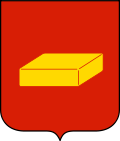Top Qs
Timeline
Chat
Perspective
Shuya, Ivanovo Oblast
Town in Ivanovo Oblast, Russia From Wikipedia, the free encyclopedia
Remove ads
Shuya (Russian: Шу́я, pronounced [ˈʂujə]) is the third largest town in Ivanovo Oblast, Russia. The town is built on the high left bank of the navigable Teza river, a tributary of the Klyazma river, with two suburbs on the right bank.[8] Population: 55,225 (2021 Census);[9] 58,486 (2010 Census);[3] 62,449 (2002 Census);[10] 69,362 (1989 Soviet census);[11] 18,968 (in 1897);[8] 19,560 (in 1882).[8]
Shuya is one of the chief centers of the cotton and linen industries in central Russia.[8]
Remove ads
History

Middle Ages
The first record of Shuya is dated by 1393.[citation needed] Annalists mention princes of Shuya in 1403.[8] Since 1403, the area was held by a branch of the House of Suzdal, which got their name "Shuysky" after the town.[citation needed] In 1539, the town was sacked by Safa Giray of Kazan.[citation needed] In 1566, it was taken by Ivan the Terrible as his personal property into Oprichnina.[citation needed]
In 1722, Shuya was visited by Peter the Great, who launched textile manufacturing there.[citation needed] The town's first linen manufactures were established in 1755.[8] Town status was granted to it in 1778.[citation needed]
Modern era
By the 19th century, Shuya was developed into a major flax-processing center, although it has been since superseded in importance by the neighboring town of Ivanovo.
Remove ads
Administrative and municipal status
Within the framework of administrative divisions, Shuya serves as the administrative center of Shuysky District,[1] even though it is not a part of it.[4] As an administrative division, it is incorporated separately as the Town of Shuya—an administrative unit with the status equal to that of the districts.[4] As a municipal division, the Town of Shuya is incorporated as Shuya Urban Okrug.[5]
Architecture
Nikolo-Shartomsky Monastery, situated 12 kilometers (7.5 mi) from Shuya, has one of the largest monastic communities in Russia. It was first mentioned in 1425. It has a cathedral from 1652 and a refectory church from 1678.
The belltower of the Resurrection Cathedral in Shuya is the tallest freestanding bell tower in the world.
Notable people
Notable people from Shuya include peasant Feodor Vassilyev, whose first wife still holds the world record for most children ever born (sixty-nine). Mikhail Frunze led textile workers in the town in a strike action during the Revolution of 1905.
Economy
According to the 1911 Encyclopedia Britannica, tanneries, especially for the preparation of sheepskins—widely renowned throughout Russia—still maintain their importance, although this industry has migrated to a great extent to the country districts.[8] The cathedral (1799) is a large building, with five gilt cupolas.[8] Nearly every village in the vicinity has a specialty of its own—bricks, pottery, wheels, toys, packing-boxes, looms and other weaving implements, house furniture, sieves, combs, boots, gloves, felt goods, candles, and so on.[8]
As of 1911, the manufacture of linen and cotton in the villages, as well as the preparation and manufacture of sheepskins and rough gloves, occupied about 40,000 peasants.[8] The Shuya merchants carry on an active trade in these products all over Russia, and in corn, spirits, salt and other food stuffs, imported.[8]
Remove ads
International cooperation
Shuya is twinned with the following cities and municipalities:
See also
References
External links
Wikiwand - on
Seamless Wikipedia browsing. On steroids.
Remove ads






